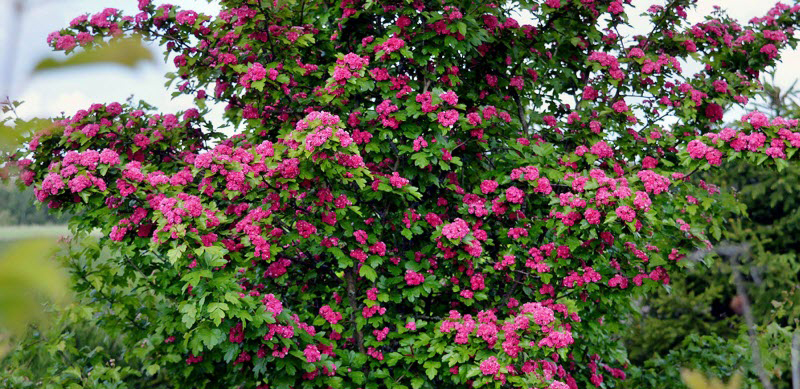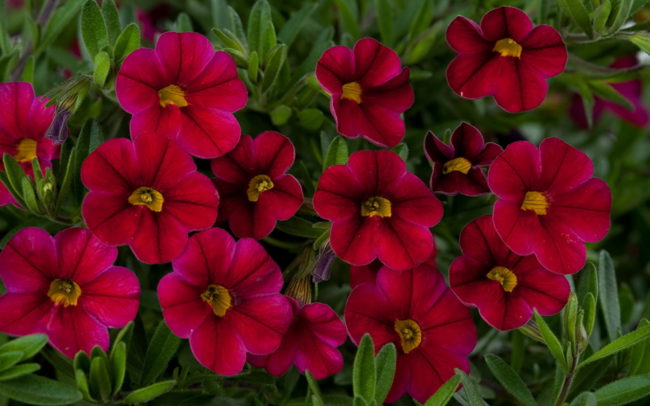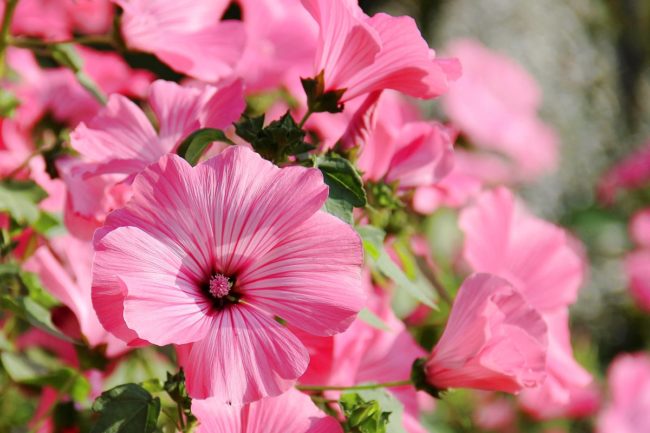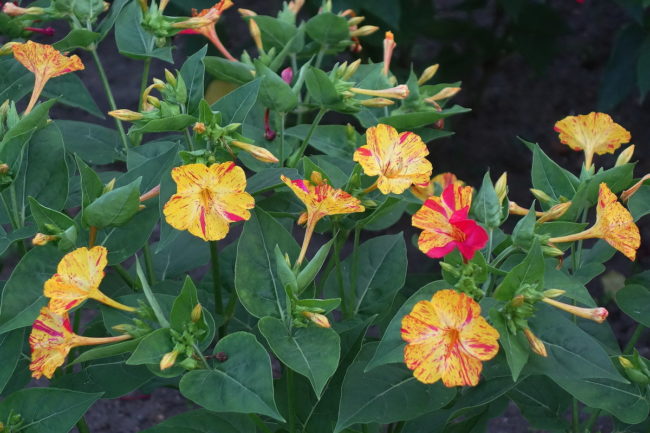What are similar plants, what are they called and what is the difference?
There are plants outwardly similar to Petunia, but not related to the nightshade species. Flowers, like Petunia, can only match in appearance. Below is an overview of flowers similar to Petunia with names and photos.
Surfinia
One of these twins is Surfinia. This is a hybrid of Petunia, which is really very similar to her.
How is Petunia different from Surfinia? In Surfinia, unlike Petunia, the stems are much longer and more powerful. In addition, Surfinia boasts a very abundant flowering. Surfinia is found in a wide variety of shades, from white to dark purple. The bloom looks like a large blooming ball.
Analogs
Mirabilis
Mirabilis belongs to the plants of the Niktagin family. The flower itself is a branching bush, which has leaves of an ovoid-elongated shape in pairs. A distinctive feature is the appearance of flowers of different colors from one bush, which bloom only at night and die in the morning. Also, Mirabis lacks a rim.
Calibrachoa
The plant is very easy to confuse with Petunia, the only difference is in the structure of DNA. An interesting feature of Calibrachoa is that small flowers have “necks” that are colored brown or yellow. The leaves, like those of Petunia, are covered with hairs.
Minitunia
A flower similar to Petunia, only smaller. The plant looks like a colored cloud due to the large number of buds on one bush.
Minitunia grows rapidly, forming strong branched shoots.
Dope
A plant from the nightshade family. Datura stalk is naked, erect, can reach 1 meter.
Datura leaves are a distinctive feature of Petunia, they have a dark green or light color. Flowers are arranged one at a time in the forks of the stem.
Datura is a poisonous plant. The name speaks for itself, the flower can be intoxicating. Prolonged contact with the plant causes poisoning.
Indoor Siningia
They differ from Petunias by the presence of a velvet flower that looks like a bell.
The roots are tuber, the leaves are thick, velvety, rosette.
Artificial
Artificial Petunias are made from quality materials. If it is not possible to have fresh flowers, then artificial ones are a great option.
It is very difficult to distinguish them from living ones, and it can please the eye all year round.
We also prepared materials about diseases, pests and varieties of petunias, growing this beauty in vertical beds and about the rules for caring for annual and perennial varieties.
The most common problems and their solutions
Calibrachoa is most often attacked by aphids and thrips, and it often suffers from whiteflies and spider mites. You can deal with them with the help of special insecticides: Aktara, Fitoverm, Aktellik, Sunmight and others. Two or three treatments are carried out in a row with an interval of seven days.
Due to violations in plant care, the following can develop:
- Blackleg develops due to a thickened planting, unsuitable soil and frequent excess watering. A symptom characteristic of the disease is the blackening and softness of the stem in the root zone. They solve the problem by removing the affected plants and treating the remaining ones with a fungicide.
- Chlorosis affects the flowering and brightness of the plant's leaf mass. This is due to an increase in the concentration of calcium in the soil and a lack of iron, a solution to the problem in regular balanced feeding.
- Powdery mildew causes a whitish bloom on the foliage, the cause of the disease is a fungus. The infected parts of the plant are removed, and the rest are treated with sulfur.

In addition to this, calibrachoa may have other problems:
- Yellowing of foliage occurs due to a deficiency of iron in the soil, excessive watering or too low a temperature of the content;
- The yellowing of the lower leaves occurs due to a lack of nitrogen, overflow or lack of soil;
- Foliage curls and dries up due to lack of light or dry air.
Reproduction methods
Petunia propagates by two methods - cuttings and seeds.
Seeds
- The seeds can be purchased from the store or harvested by yourself after flowering and fruit formation. The bicuspid capsule (fruit) cracks after ripening, and the seeds spill out.
- The ideal time to sow seeds is mid to late March. At this time, the length of daylight hours is sufficient for normal seed germination.
- Petunia seeds are quite small, they must be scattered over the surface of the substrate in a pot at home or on the street and covered with foil and glass.
- Seeds should not be placed close to each other.
- The room temperature should be 23-25 degrees.
- Watering should be moderate, you can use a spray bottle and spray the surface of the substrate.
- Seedlings should appear in about a week. After that, the temperature must be lowered to 20 degrees, and the greenhouse must be periodically ventilated.
- A pick is carried out when 3-4 leaves are formed.
- Fertilize after the seedlings grow a little. Complex fertilizers are suitable for feeding.
- Landing in the ground is carried out when the spring frosts end.
- Flowering will appear in about 2-3 months after germination.
We offer you to watch a video about growing petunia seeds:
Cuttings
Reproduction by cuttings is suitable for terry and ampel type petunias. Terry varieties are propagated in late February, early March, ampelous can be propagated all year round (read about petunia varieties here). On condition of constant supplementary lighting with fluorescent lamps and creating the required temperature of 21-24 degrees.
- For propagation by cuttings, the apical cuttings must be cut off. They should have 4 to 6 leaf plates.
- On each cutting, you must remove all the leaves, leaving the top two.
- The remaining leaves must be cut in half.
- Cuttings are planted for rooting in a substrate used for propagation of petunias by seeds.
- Before planting on top of the prepared soil, it is necessary to lay a layer of perlite or sand 20-25 mm thick. Perlite or sand must be treated with a fungicide solution to disinfect the soil.
- Cuttings are planted at a distance of 15-20 mm from each other.
- For cultivation, it is necessary to create a greenhouse by covering the container with Petunia with glass or film.
- The substrate should be moistened with a spray bottle twice a day.
- Rooting occurs in a week.
We offer you to watch a video about petunia cuttings:
Growing and caring for calibrachoa
Calibrachoa needs a lot of heat and light to grow well. Sunny terraces or balconies with a south-east or south orientation are very good for calibrachoa. But without the searing heat. With an aggressive midday sun, the plant can burn out - you need to shade it during these hours.

Calibrachoa does not like strong winds, which can ruffle and tear the stems, as well as flowers. An open balcony on the very top floor of a high-rise building is not the best place for a plant. Calibrachoa is best grown in a sheltered location.

Calibrachoa are planted in balcony boxes, flowerpots, hanging baskets. One plant will require at least 3 liters of land. The substrate should be light, preferably with plenty of leavening agents.
Calibrachoa needs much less moist soil than petunia. On the contrary, moisture is unacceptable.Calibrachoa is easy to pour, and its delicate roots rot, and the plant itself dies. Calibrachoa loves constant spraying. On hot days, do not be greedy for water and spray calibrachoa 3 times a day.

Throughout the growing season, caring for calibrachoa involves intensive feeding. Be sure to fertilize once a week. When budding and flowering calibrachoa, use formulations with a high content of potassium and phosphorus.
For constant flowering, wilted flowers must be cut off so that seeds are not tied. In the second half of summer, when the flowering becomes weaker, you can prune the stems. This will be a good stimulation for the branching and laying of young buds.

Reproduction of calibrachoa
The plant propagates vegetatively, that is, by cuttings. This does not mean that the plant does not form seeds - but ... The problem is that the plant does not grow from seeds like its "parents". Grown from calibrachoa seeds, it may bloom poorly, flowers may be of the wrong color, small in size.

The best option is propagation by cuttings. To do this, in early autumn, cut off the apical cuttings 4 cm long from the mother liquor. Tear off the bottom leaves and plant in wet soil. For the cuttings to take root, place them in a greenhouse. Or, cover the stem with a plastic cup and open it for a few minutes daily.

In the "greenhouse" cuttings root well. Then you can take care of the calibrachoa cuttings like houseplants. They are unpretentious and survive the winter. In the spring, the apical cuttings are cut off from the grown bushes and re-rooted - from them, calibrachoa is grown.
Top 5 annuals similar to petunia
There are a lot of such flowers. Although in appearance they are similar to petunias, they may differ in the rules of care, the method of planting, inflorescences or the shape of the bush. Therefore, they will be an excellent replacement in those areas where the petunia itself does not take root. This can sometimes be due to soil composition or climatic conditions.
Surfinia
A hybrid of petunias, but differs in a longer flowering period (from April to cold weather) and branched stems. Has a varied color - from white to purple. Grows up to two meters. The diameter of the flower itself is 5-6 cm. It is unpretentious, but to get a lush bush, you will have to adhere to several criteria:
- good illumination;
- temperature is not lower than 10-15 degrees;
- periodic, abundant watering;
- neutral soil composition;
- application of mineral fertilizers in spring and autumn;
- timely pruning of shoots;
- protection from wind and rain.

Shrubs blooming lushly all summer Designing a recreation area in the garden, decorating unsightly corners of the backyard is a time-consuming task ....
Calibrachoa

Can't stand hot sunlight. Therefore, in the sun, the plant must be shaded. Otherwise, the calibrachoa will die. Flowers in the form of bells of various shades. Many people confuse it with petunia. Indeed, they have a related origin, but they are genetically different - petunia is simpler. Calibrachoa flowers are small - 1-3 cm in diameter. Hard stems reach 1-1.5 m in length, completely covered with bells. Propagated by cuttings or seeds. A heat-loving flower does not tolerate sudden gusts of wind. Care is simple, the main thing is not to water too often, to spray and fertilize on time.
Interesting!
The natural shade of Calibrachoa flowers is violet.
Minitunia

Another petunia hybrid, but its inflorescences are small. Possesses small stature, branched and strong shoots. It blooms profusely - it resembles a cloud of blue, pink and yellow hues. Will bring zest to landscape design with its striking appearance. Can be used for curbs, pots, lawns. Small varieties of petunias are sometimes also called.

7 unpretentious shade-loving indoor plants Not all places in the apartment are sunny, and many flower lovers are looking for unpretentious indoor plants that can ...
Lavatera

Unpretentious in care, drought-resistant and frost-resistant. Photophilous, but develops well in the shade. Not demanding on the composition of the soil. Reaches a height of 1 m 20 cm. Differs in angular volumetric foliage. It is complemented by spectacular flowers of two types: racemose, single. Suitable for growing in a garden (near trees), flower beds with several types of flowers and creating an independent composition. Requires the installation of a support and a garter.
Mirabilis

Bushes of compact size grow up to 70-80 cm. In rare cases, Mirabilis is 1 m high. The branches are straight and dense, the foliage is elongated, the rhizome resembles a carrot. Color: yellow, orange, lilac, raspberry. There are spotted, striped and multi-colored varieties. Flowering continues until late autumn. At the same time, a sweet aroma comes from the plant. Choose a well-lit, warm, draft-free location for planting. Not picky about the composition of the soil.

The most beautiful shrimp flower that brings good luck The tropical plant Beloperone looks very unusual. Due to the interesting structure of the inflorescences, it is also called ...
On a note!
Mirabilis does not require much maintenance, but it does require regular loosening of the soil and timely watering. Keep in mind that the flower does not tolerate stagnant water.
Now all that remains is to choose the plant you like and start it on your site or loggia. Some of the flowers presented are perennials in their natural environment. But it is in Russia that they are grown as annuals. This is due to the country's climate.
6 diseases and pests
- Unfortunately, petunia, if agricultural technology is violated, can suffer from the appearance of fungal diseases - for example, powdery mildew and gray rot.
- Blackleg often appears on seedlings when kept in conditions of high humidity and inadequate ventilation of crops.
- Sometimes, with too thick cultivation and high humidity, plants fall ill with late blight.
- Chlorosis appears when watering with unstable tap water - the leaf blades turn yellow, and the veins remain green.
- Direct sunlight on leaves with water droplets can cause sunburn.
- Growing in pots that are too large leads to acidification of excess soil that has not been absorbed by the root system.
- Watering with cold water will lead to rotting of the root system.
- Rot will also appear with insufficient drainage and too abundant and frequent watering, especially in the cold season.
Of the pests, plants can be susceptible to an invasion of spider mites. Keep the air humidity high enough to avoid these pests.
Whitefly, aphids and thrips liked the flower. When grown outdoors, slugs and snails can take a liking to the plants.
Insects are pests
| Insect name | Signs of infection | Control measures |
| Whitefly | Small light spots on leaf blades, yellowing and foliage falling off. Disturbed white, small butterflies take off from the surface of the leaves | Chemicals: Zeta, Rovikurt, INTA-VIR, Fufanol and even Karbofos, Actellik, Aktara, Confidor, Commander, Tanrek. Folk remedies: soap solution, garlic solution, infusion of yarrow and tobacco, infusion of dandelions, adhesive traps for adult insects |
| Spider mite | Subtle spider webs on the leaves, yellowing and foliage falling off with extensive lesions. The surface of the sheet plates becomes dead and covered with small cracks. Plant development slows down. | Folk ways. Plants can be rinsed in the shower and left in the bathroom in a humid atmosphere for half an hour. Irradiation with an ultraviolet lamp every week for 2 minutes. Chemical preparations based on pyrethrum, sulfur powders, Fitoverm, Actellik. |
| Aphid | Sticky droplets appear on the leaf plates, the leaf plates curl and deform, delicate buds and young leaves wither.Insect colonies can be seen on the tops of the shoots, buds or the underside of the leaf plates. The flowers of aphid-infested plants may become deformed. | Folk methods: infusion of nettle, decoction of rhubarb leaves, wormwood, soap solution, infusion of tobacco and dandelion, onions, marigolds, yarrow, tansy, dusting with wood ash. Chemical preparations: Sulfur powders, green mass treatment with green potash soap without getting into the ground, Decis, Aktellik, Fitoverm. |
| Thrips | The appearance of yellow spots on the leaf blades, small brown dots can be observed on the underside of the leaves. When spread, the pests cause the leaves to turn yellow, dry and fall off. | Folk ways. Increase the humidity of the air, wipe the surface of the leaves with soapy water to reduce the number of pests. Preparations based on pyrethrum - 2-fold treatment with an interval of 7 - 10 days, spraying with tobacco infusion, infusion of yarrow or Persian chamomile, decoction of cyclamen tubers. Chemical preparations: dusting with sulfur powders, the use of anabazine - sulfate in a soapy solution. |
| Snails, slugs | Through holes in leaf blades, traces of mucus on the surface of the leaves. | Folk methods: manual collection of harmful insects, dusting plant leaves with mustard and hot pepper, wood ash mixed with baking soda, tobacco dust. Chemicals: superphosphate granules, copper preparations, Thunderstorm, Slime-eater, Antislice, Meta. |
-
Whitefly
-
Spider mite
-
Aphid
-
Thrips
-
Slugs and snails
Growing Million Bells
The Million Bells varietal series includes about 18 varieties with pink, pink-lilac, purple, cherry, red, lemon-yellow, raspberry, dark yellow color.
At first, the flowers of the calibrachoa were purple - this is the "native" coloring of the plant. Later, when the plant interested breeders, varieties with red, white, pink, yellow, blue, brown colors were bred.

A distinctive feature of calibrachoa is that its flowers have a “throat” that differs in color from the corolla. The throat can be brownish or yellow.
As a rule, the calibrachoa flower is simple, resembling a petunia bell. But today you can also see terry varieties, which are slightly inferior in the splendor of flowering to common calibrachoa.



